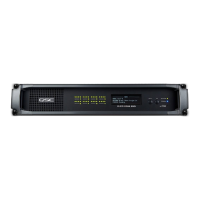9
TD-000347-00-B
QSC DataPort Amplifi ers
QSC DataPort amplifi ers (PowerLight™, CX, PL2, DCA, and PL3) can be used in a Q-Sys system to communicate with the Q-Sys DataPort card and
provide critical telemetry information and protection for both the amplifi er and any loudspeaker. With QSC loudspeaker connected to a DataPort
amplifi er and Q-Sys, you get additional information and benefi ts not available with generic loudspeakers. Generic amplifi ers can be used in a Q-Sys
system by connecting the amplifi er to a Line Out connection; however, there is no telemetry or control of either the amplifi er or loudspeakers (even
QSC loudspeakers) if Line Out cards are used.
Loudspeakers
Q-Sys, QSC DataPort amplifi ers, and QSC loudspeakers work together to form an integrated system that provides specifi c loudspeaker processing
(Intrinsic Correction™), telemetry, and protection for the loudspeaker. You can use generic loudspeakers in a Q-Sys system, however there is no
Intrinsic Correction provided.
Redundancy
Q-Sys is capable of several redundant confi gurations to ensure a high level of overall system reliability.
•
2N Core redundancy
— Two Cores, primary and redundant, communicating with each other and peripherals to verify system health, and to
synchronize control settings.
•
2N Network redundancy
— Two separate networks - In this confi guration, you can have each Q-Sys Core and/or I/O Frame connected to
both networks.
•
2N I/O redundancy
For each I/O Frame, you can have a backup I/O Frame.
•
N+1 Amplifi er redundancy
— One amplifi er can back up from one to eight amplifi ers with the Q-Sys DAB-801 (DataPort Amplifi er Backup).
Network Redundancy
The Core, I/O Frame, I/O-22, and TSC-8 have two network ports, LAN A (primary), and LAN B (backup). The LAN B port on a unit becomes active
when it is confi gured in Q-Sys Designer as “Is Network Redundant” and connected. Because the every unit is confi gured in the design fi le, the Core
recognizes it as being on LAN B as well as LAN A. During operation, the Core routes audio and control signals to both ports, so if LAN A, or a part of
LAN A fails, the Core switches to LAN B with no failover time.
Q-Sys Hardware Redundancy
The Cores and I/O Frames can have backups connected to the network. Both are identifi ed in Q-Sys Designer as being redundant. The backup Core
communicates with the primary to ensure it is up to date with any changes made on the primary, and to monitor the primary Core’s health. The Core
monitors the I/O Frames, if there is a problem detected with the primary I/O Frame, the Core switches to the backup. The audio inputs and outputs of
the primary and backup I/O Frames are wired in parallel, meaning that the audio source drives two inputs. The audio outputs of an offl ine I/O Frame
are disconnected by relays, so only the active I/O Frame, in a redundant pair, drives the outputs.

